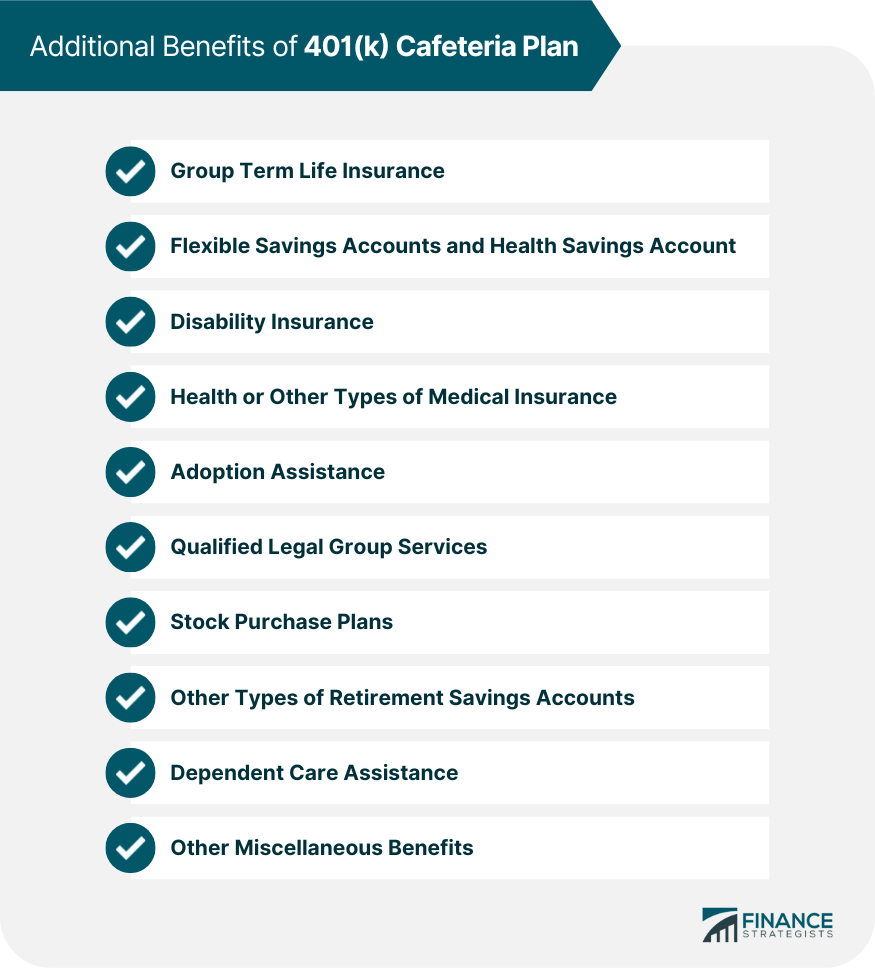A 401(k) cafeteria plan allows employees who are participating in their employer's 401(k) plan to also choose additional types of benefits from a smorgasbord of options on a pretax basis. Have questions about 401(k) Cafeteria Plans? Click here. These benefits can include: Cafeteria plans are organized under Section 125 of the Internal Revenue Code and thus are often called "Section 125 plans" or "flexible benefits plans." This flexibility, however, makes these plans more difficult to administer than other types of benefit plans. Section 125 plans are typically more complex in design than other more straightforward types of employee benefit programs. In principle, Section 125 plans are designed to prevent any type of deferment of employee income or compensation except through a 401(k) or other types of qualified retirement savings plan. Cafeteria plans are well-suited for larger companies that have a diversified workforce made up of single employees, employees with spouses and/or families, older workers and recent graduates. This type of plan can offer useful benefits to employees of all types who have differing needs and goals. For example, a young single college graduate may be focused primarily on getting out of debt or saving for retirement, while a married employee with several children is more likely to be interested in medical coverage and medical savings accounts. Cafeteria plans are offered on a pretax basis, which leverages their value to employees. Section 125 of the Internal Revenue Code states that the amount of money that an employee contributes to cafeteria plan benefits is not factored into that employee's gross income calculation. No Social Security or Medicare taxes are deducted from Section 125 contributions except under certain specific circumstances. At the beginning of each year, Section 125 plan participants must decide how much money they are going to contribute to their plan for the year. This amount is then divided equally among pay periods and deducted from the employer's pay. Any amount that the employee allocates to the plan that is not spent by the end of the year is forfeited. If an employee uses up their full allocation of plan contributions and then leaves the company during the year, then the employer has to absorb the loss of unpaid contributions.
Who Are Cafeteria Plans For?
Tax Considerations
Contributions and Withdrawals
401(k) Cafeteria Plan FAQs
A 401(k) plan is a retirement plan offered by an employer designed to help employees save for retirement.
A 401(k) cafeteria plan allows employees who are participating in their employer’s 401(k) plan to also choose additional types of benefits from a smorgasbord of options on a pretax basis.
With a Roth 401(k), taxes are paid as money is put into the retirement account. With a traditional 401(k), taxes are paid as money is taken out.
Alternatives to 401(k) plans include traditional IRAs, Roth IRAs, pension plans (if your employer offers one), and 403(b) retirement plans for employees of non-profit organizations.
These plans are sometimes referred to as Section 125 Plan (from the applicable IRS code) or a flexible benefits plan.
True Tamplin is a published author, public speaker, CEO of UpDigital, and founder of Finance Strategists.
True is a Certified Educator in Personal Finance (CEPF®), author of The Handy Financial Ratios Guide, a member of the Society for Advancing Business Editing and Writing, contributes to his financial education site, Finance Strategists, and has spoken to various financial communities such as the CFA Institute, as well as university students like his Alma mater, Biola University, where he received a bachelor of science in business and data analytics.
To learn more about True, visit his personal website or view his author profiles on Amazon, Nasdaq and Forbes.















